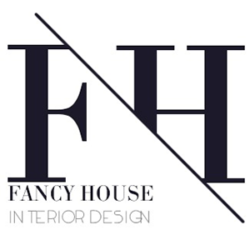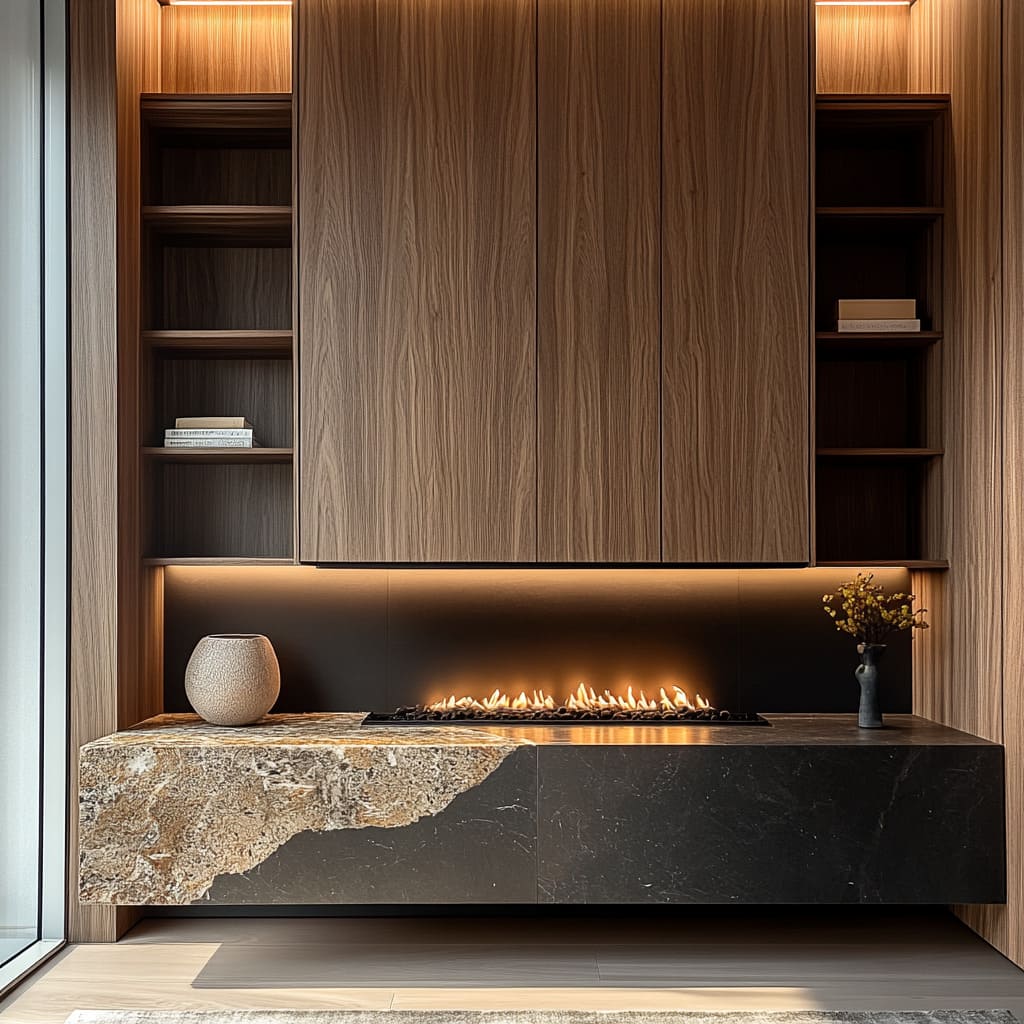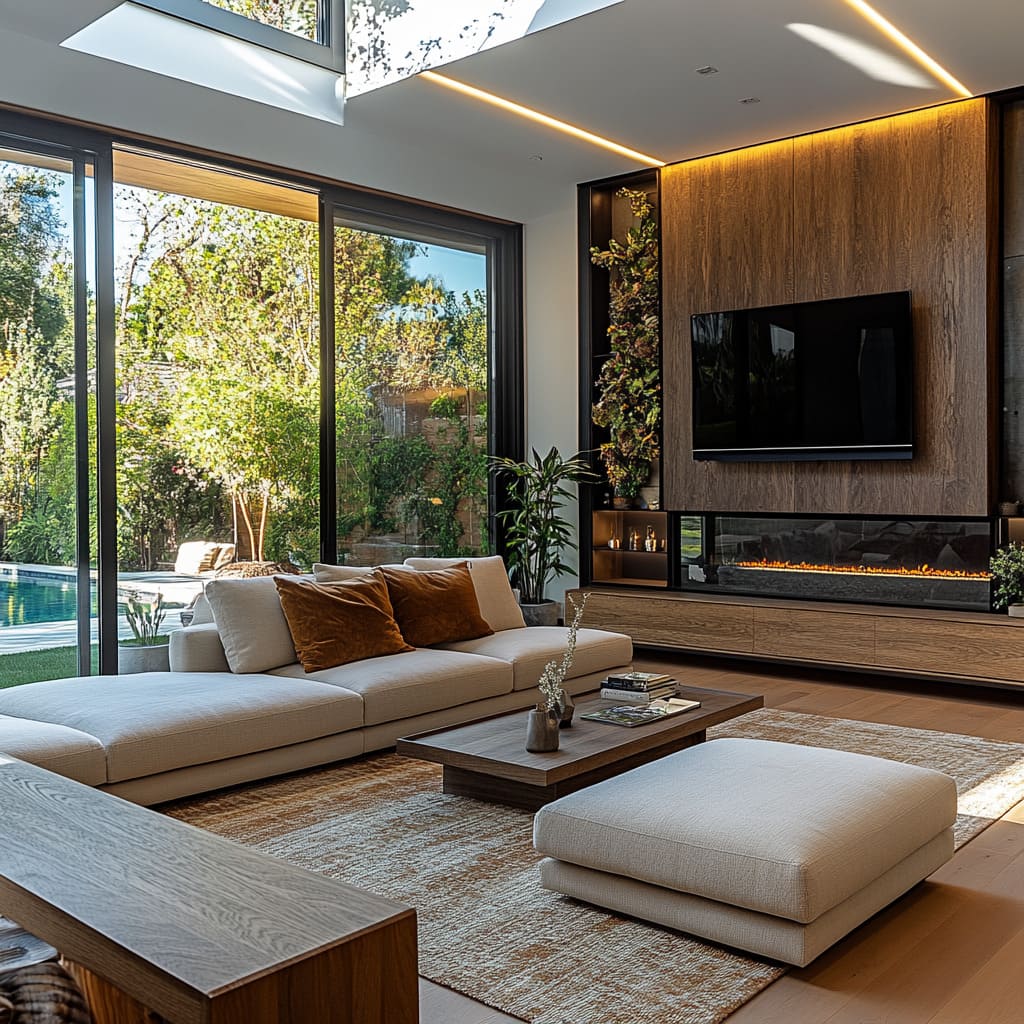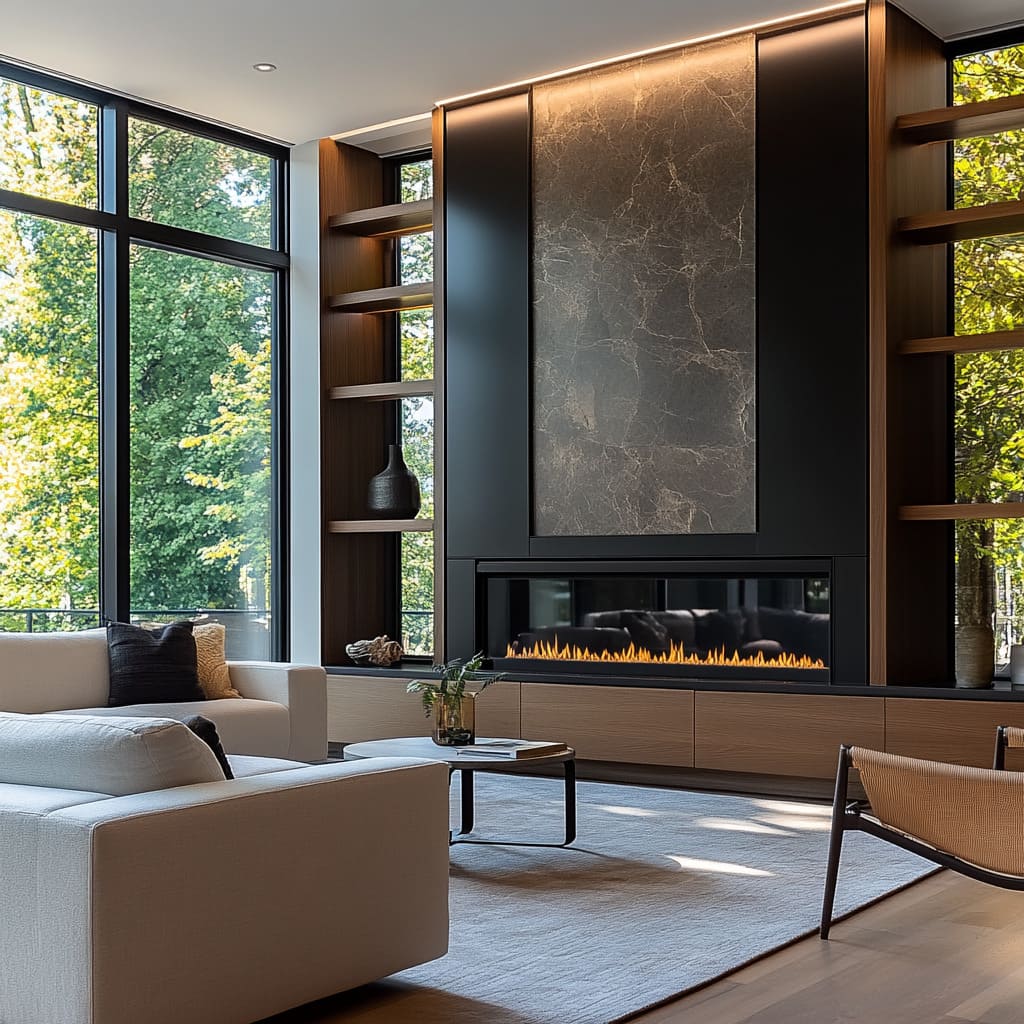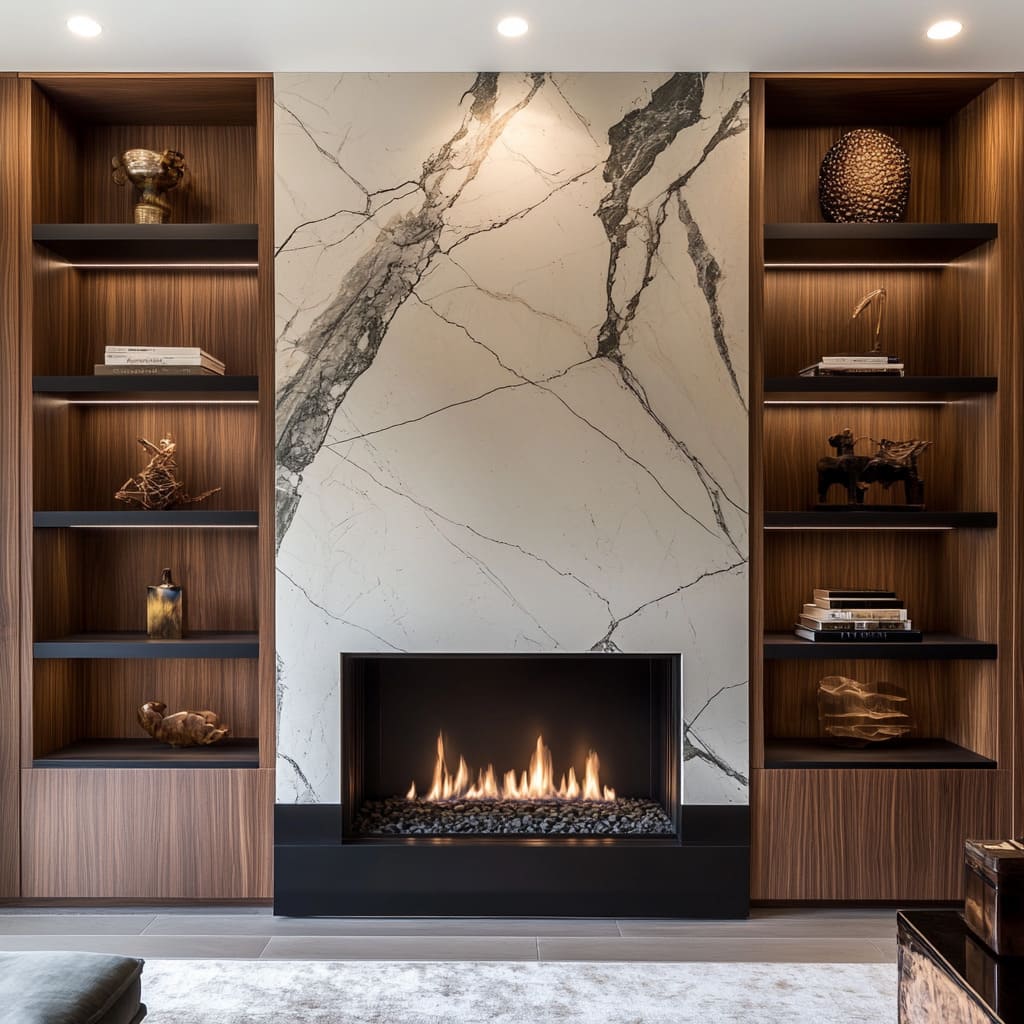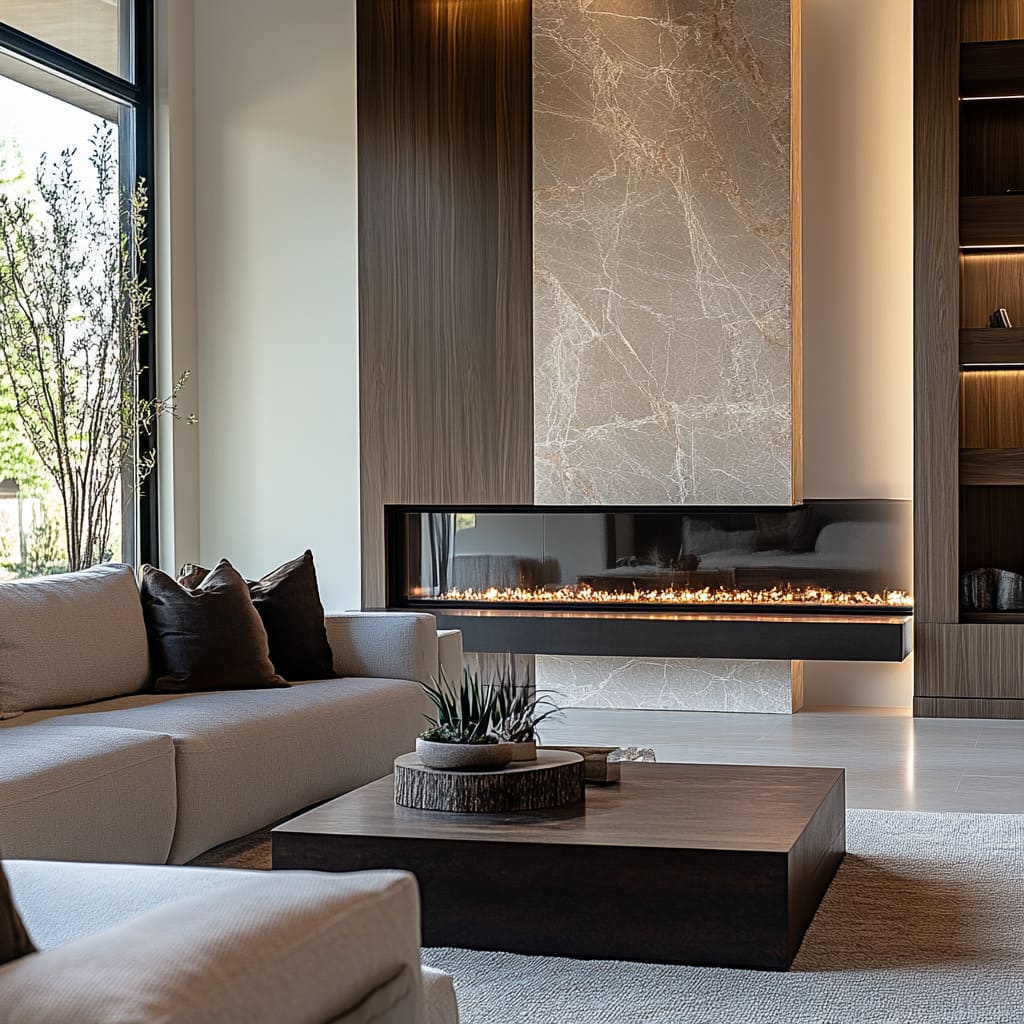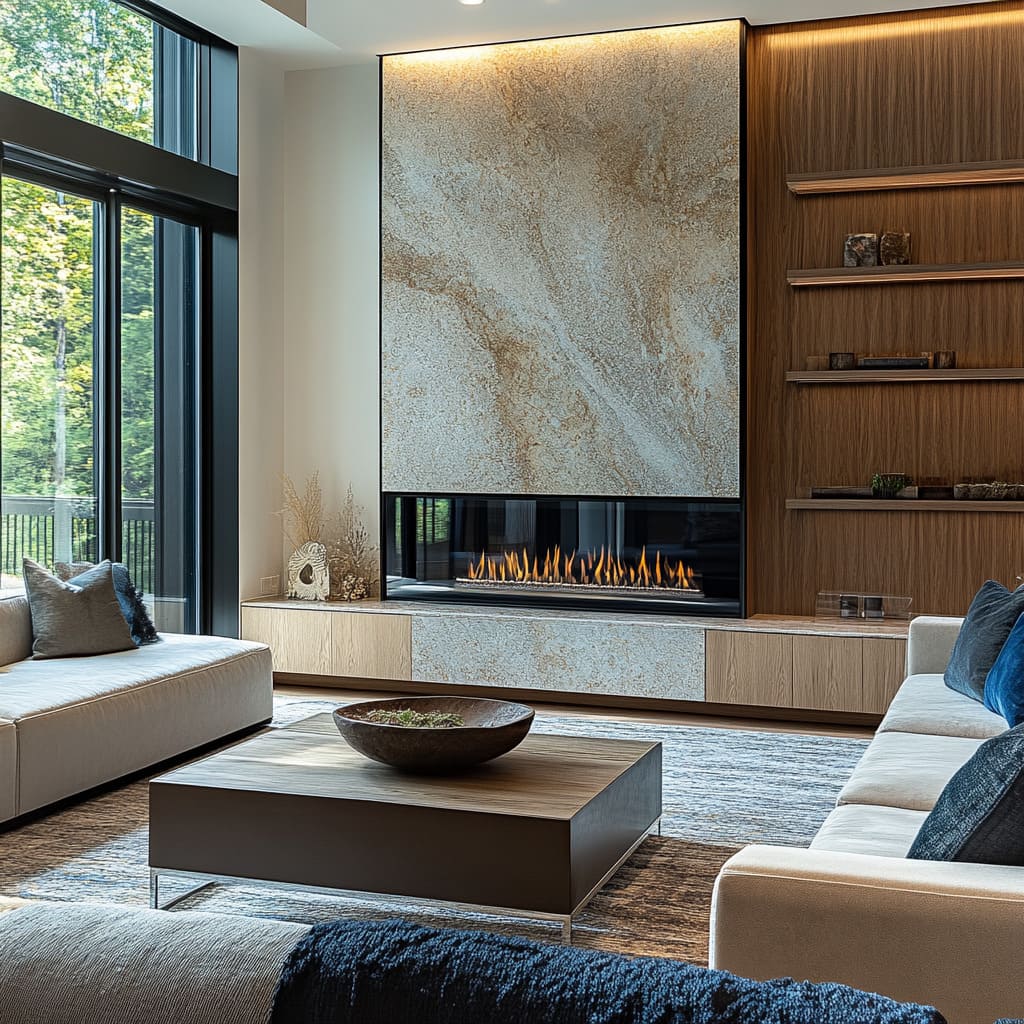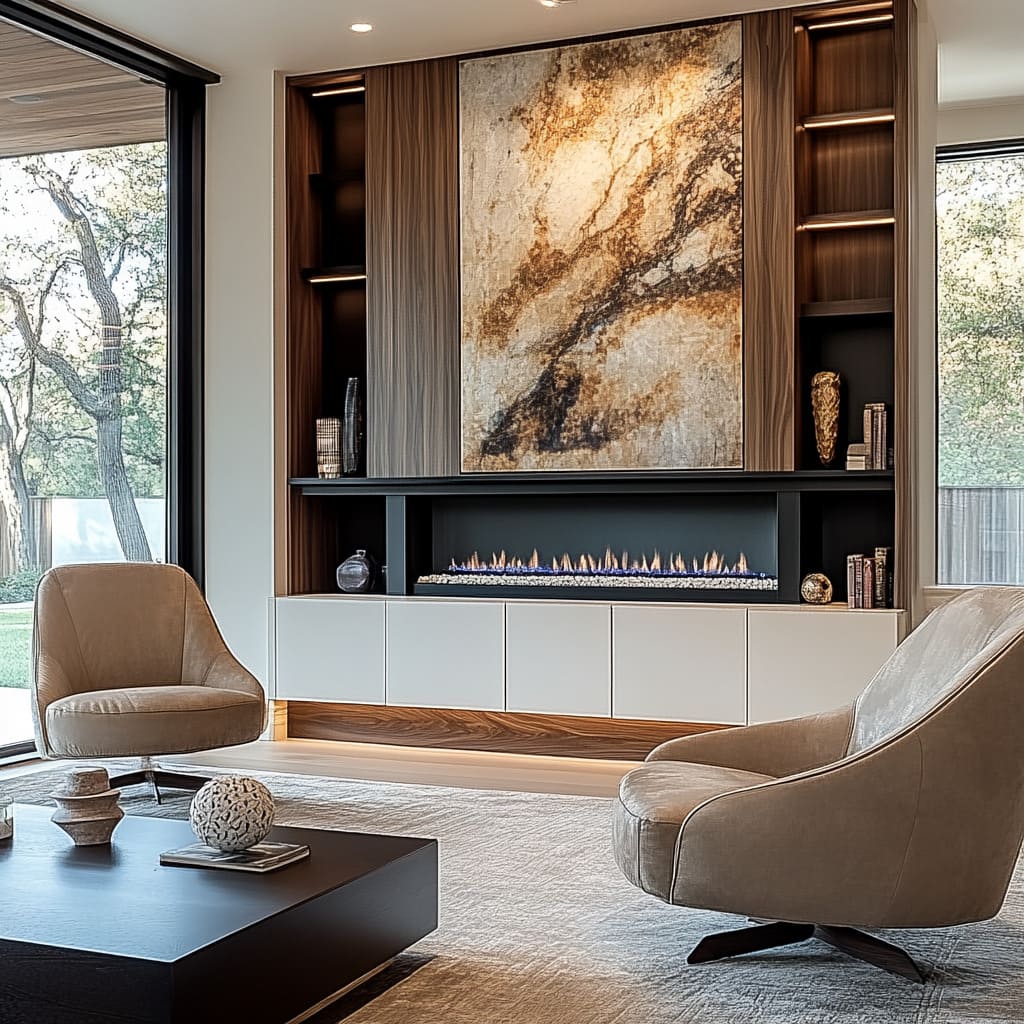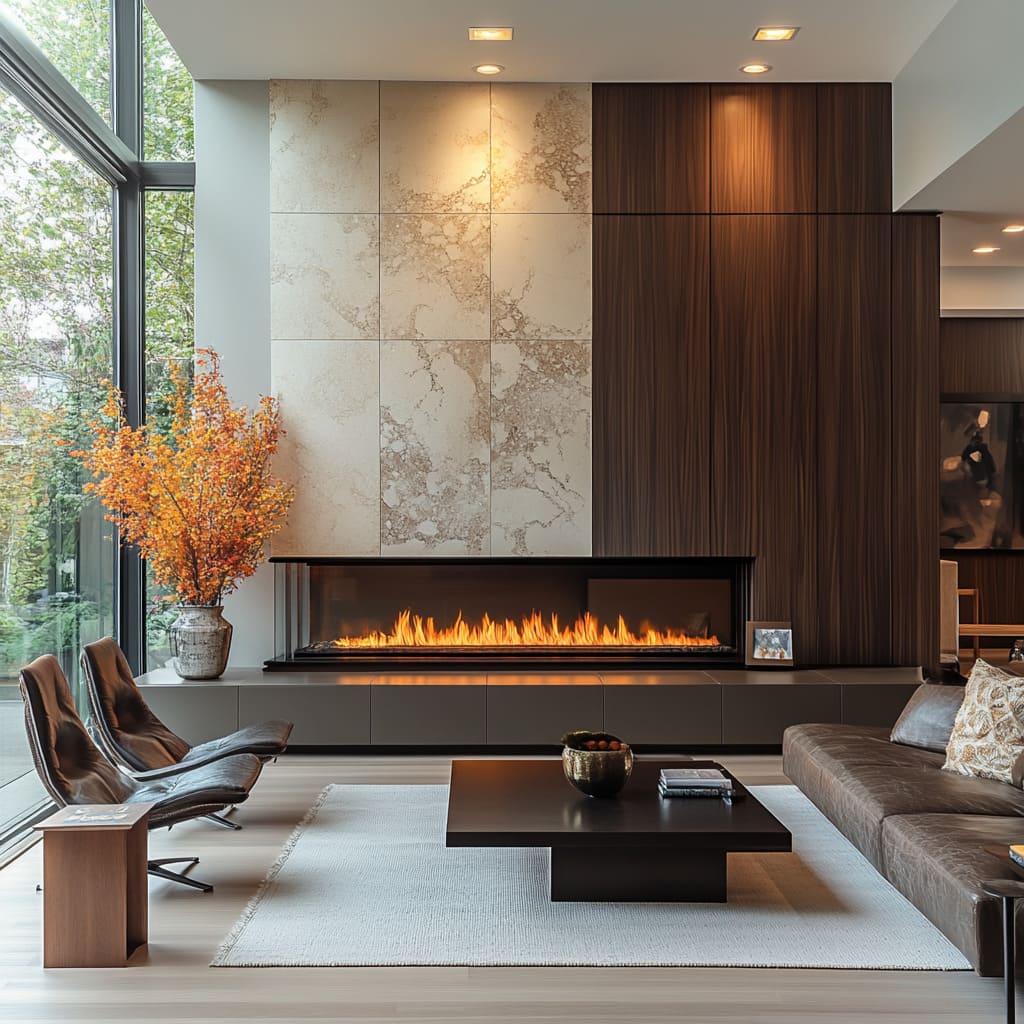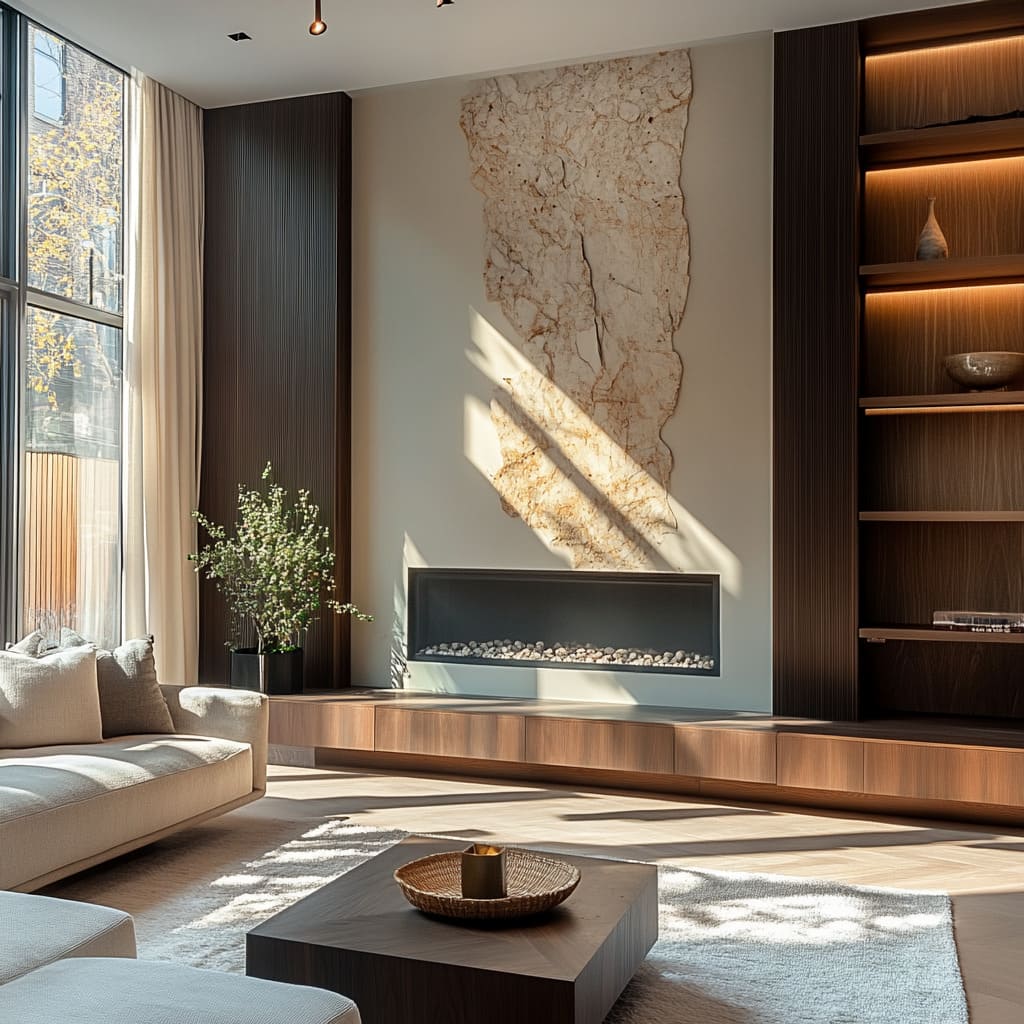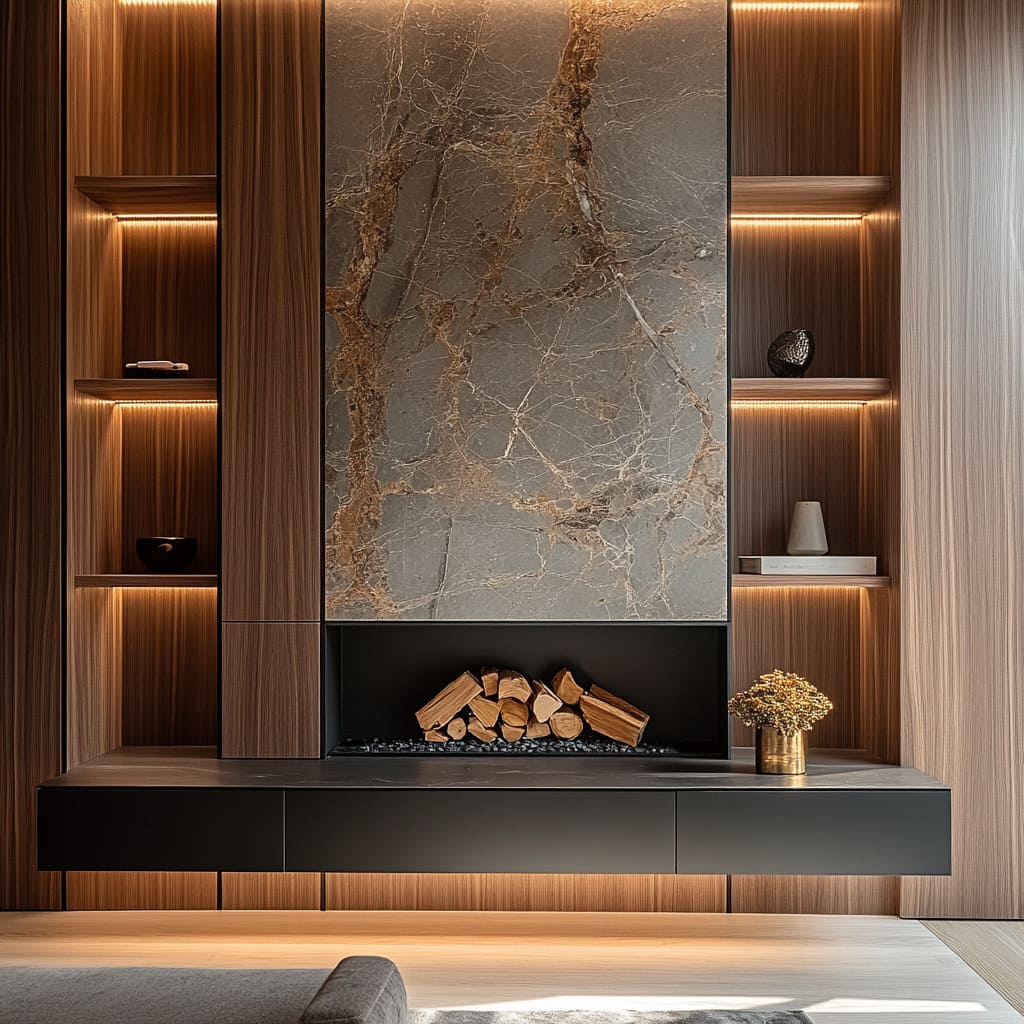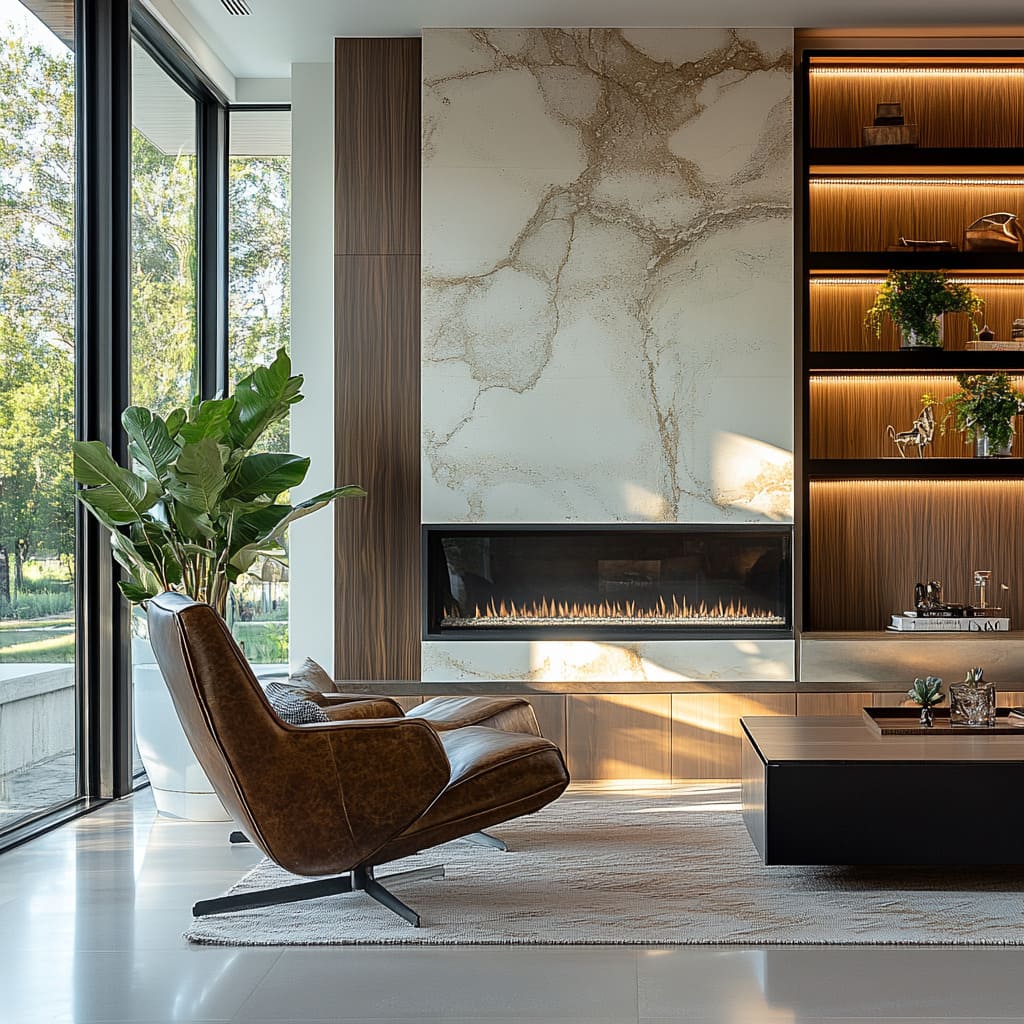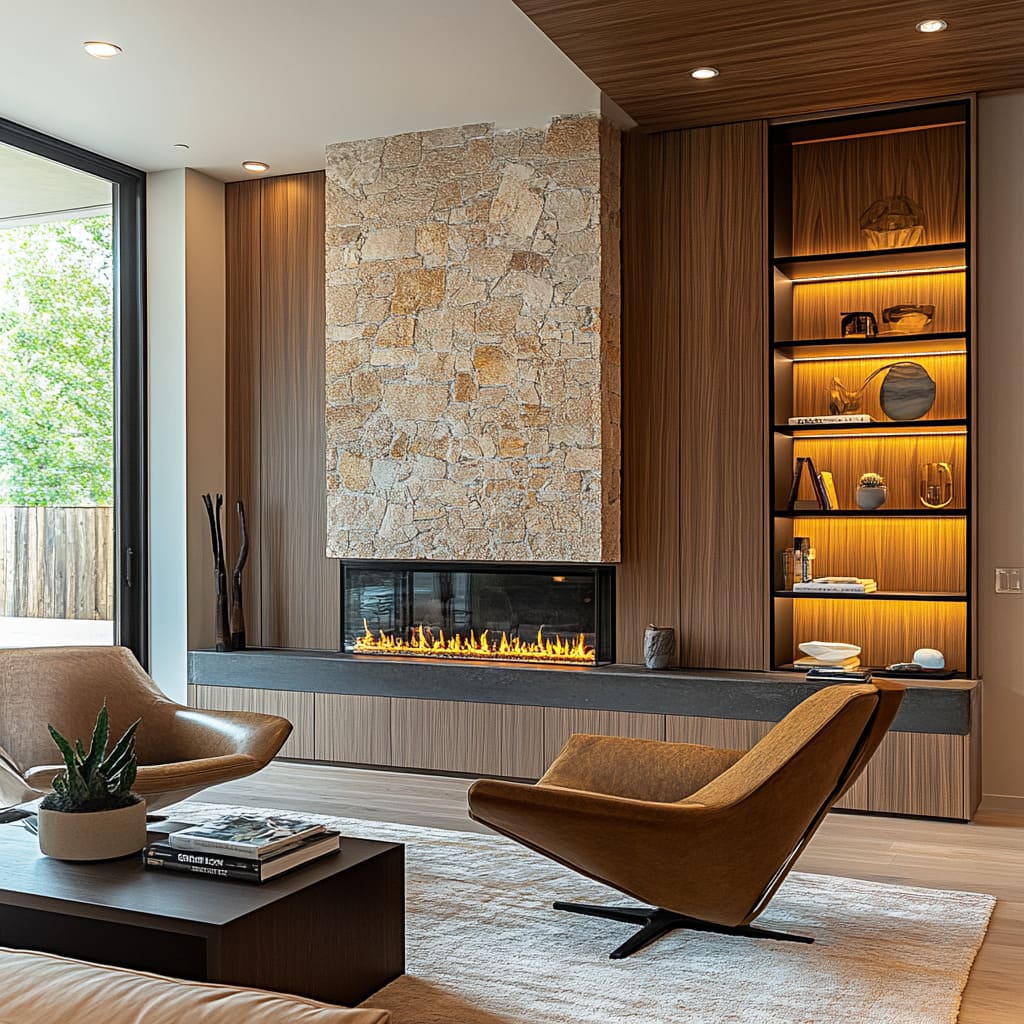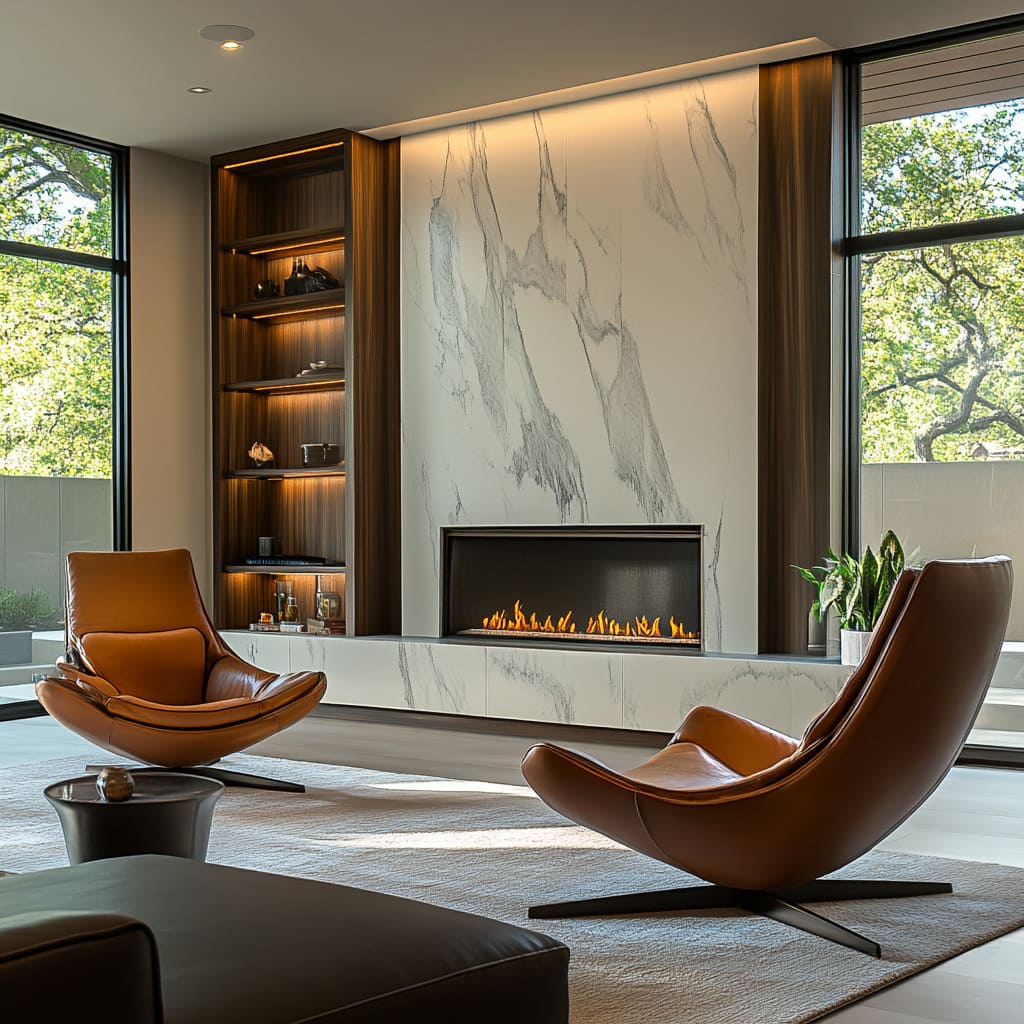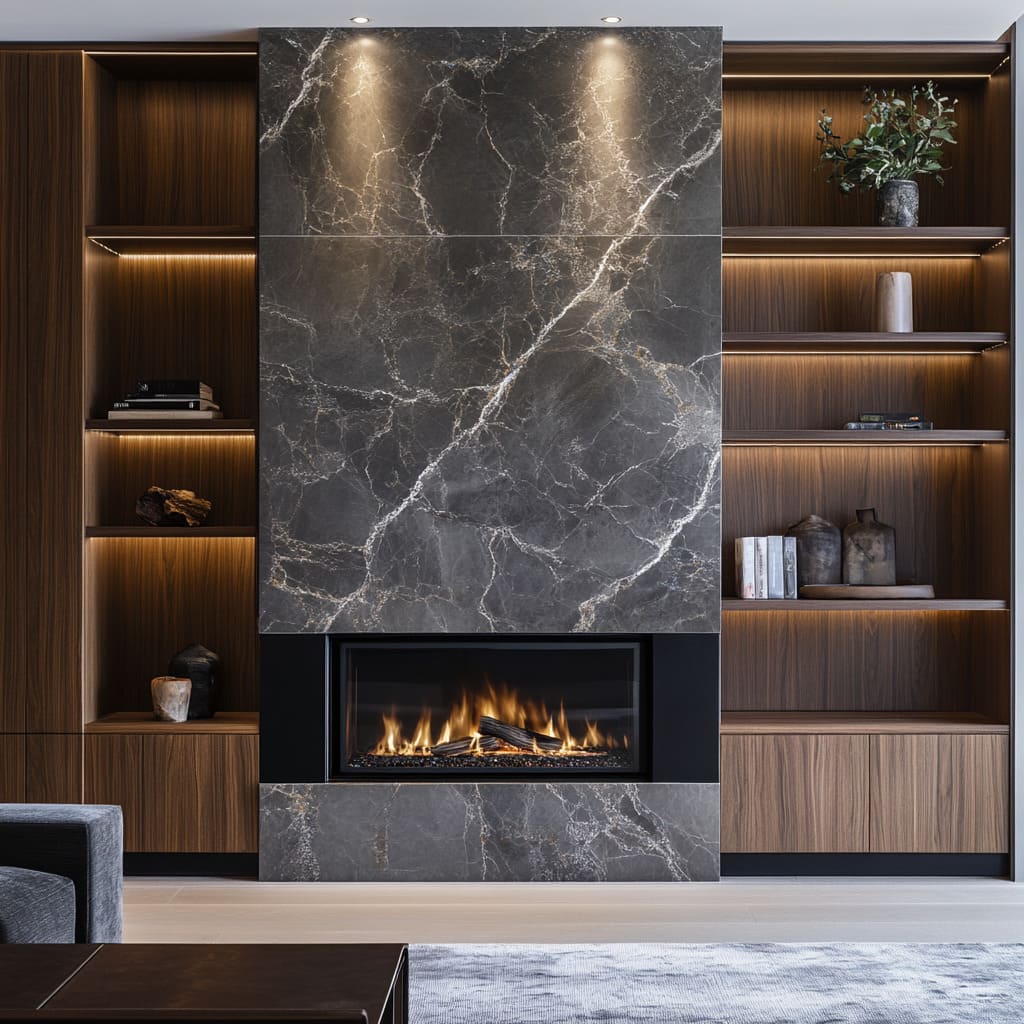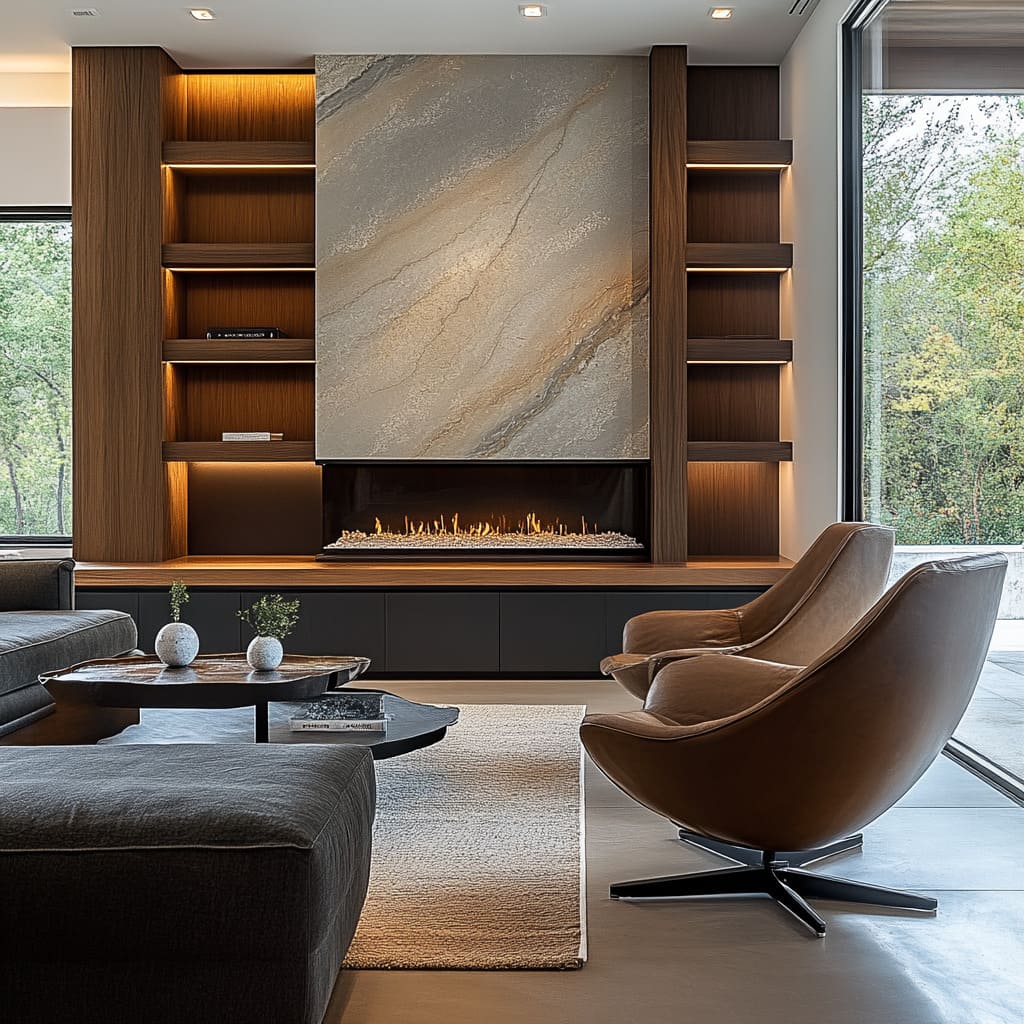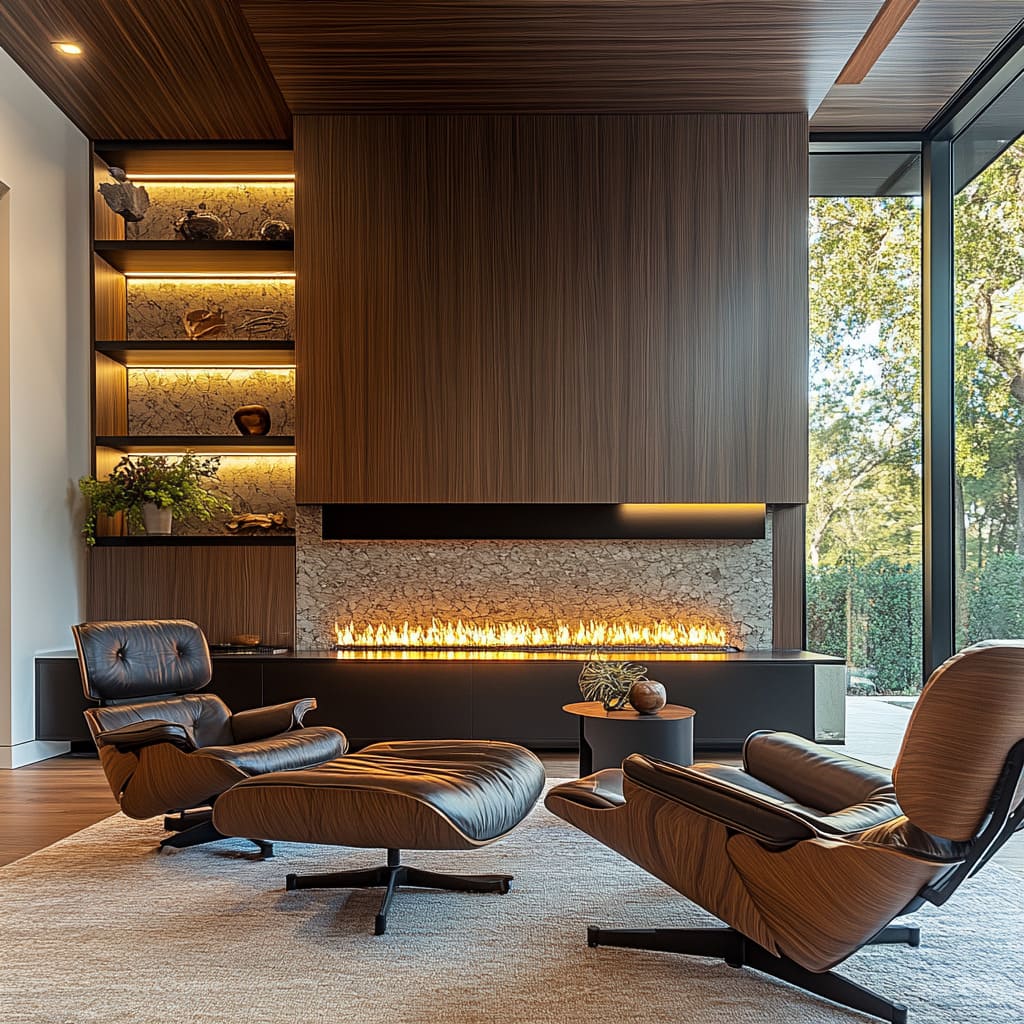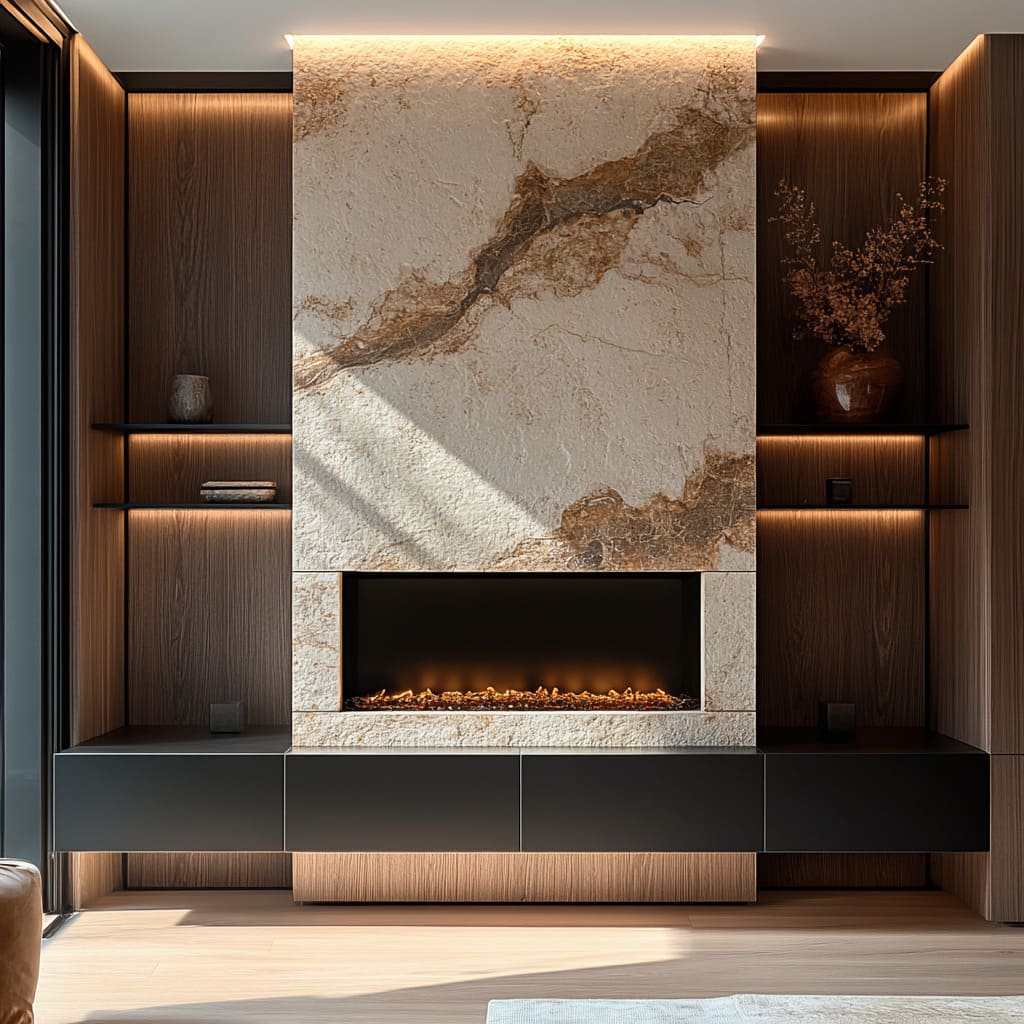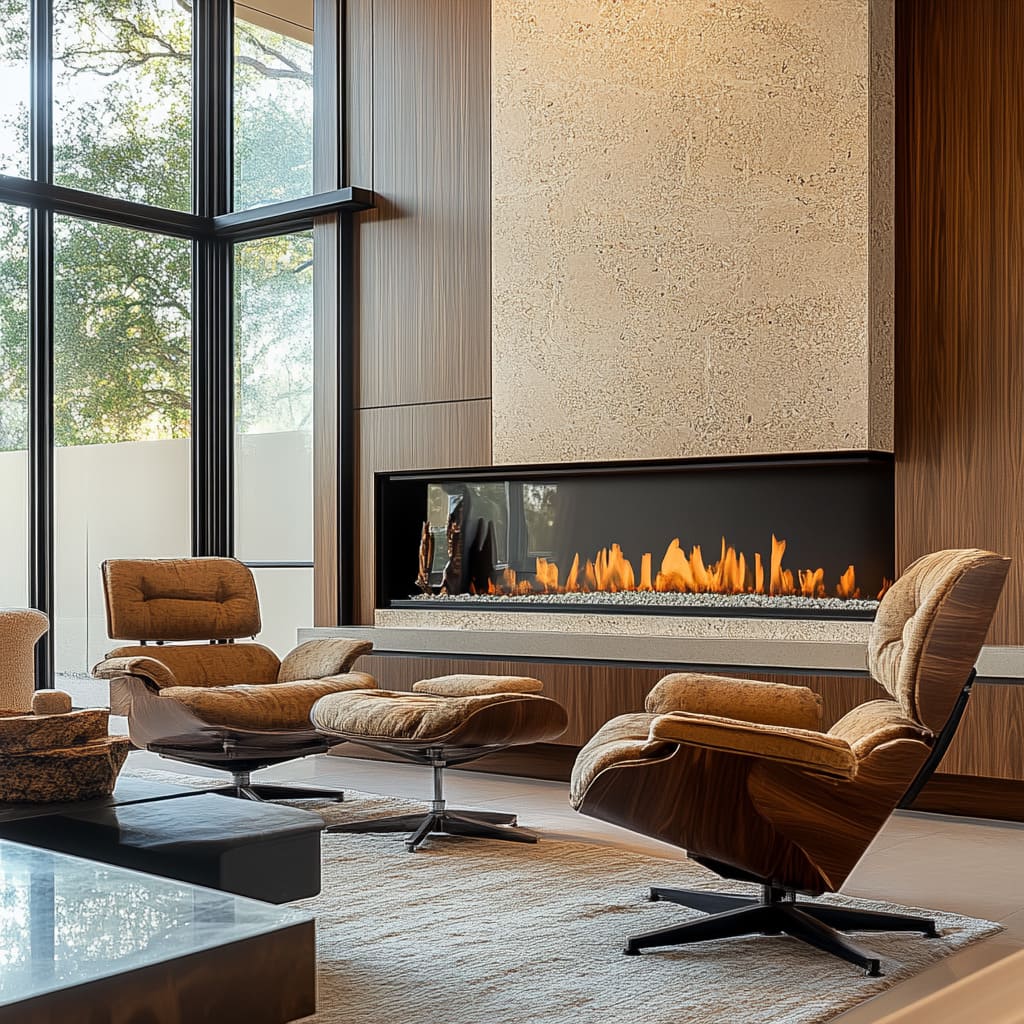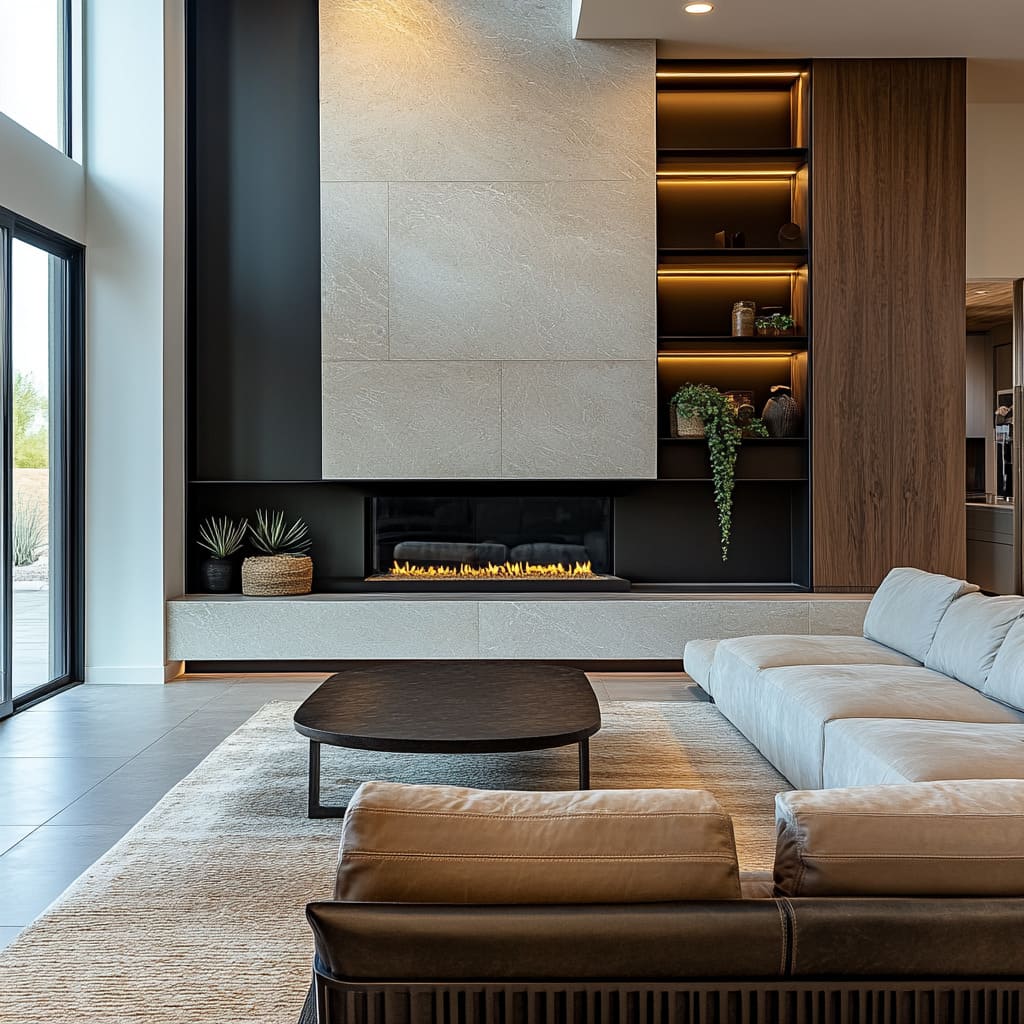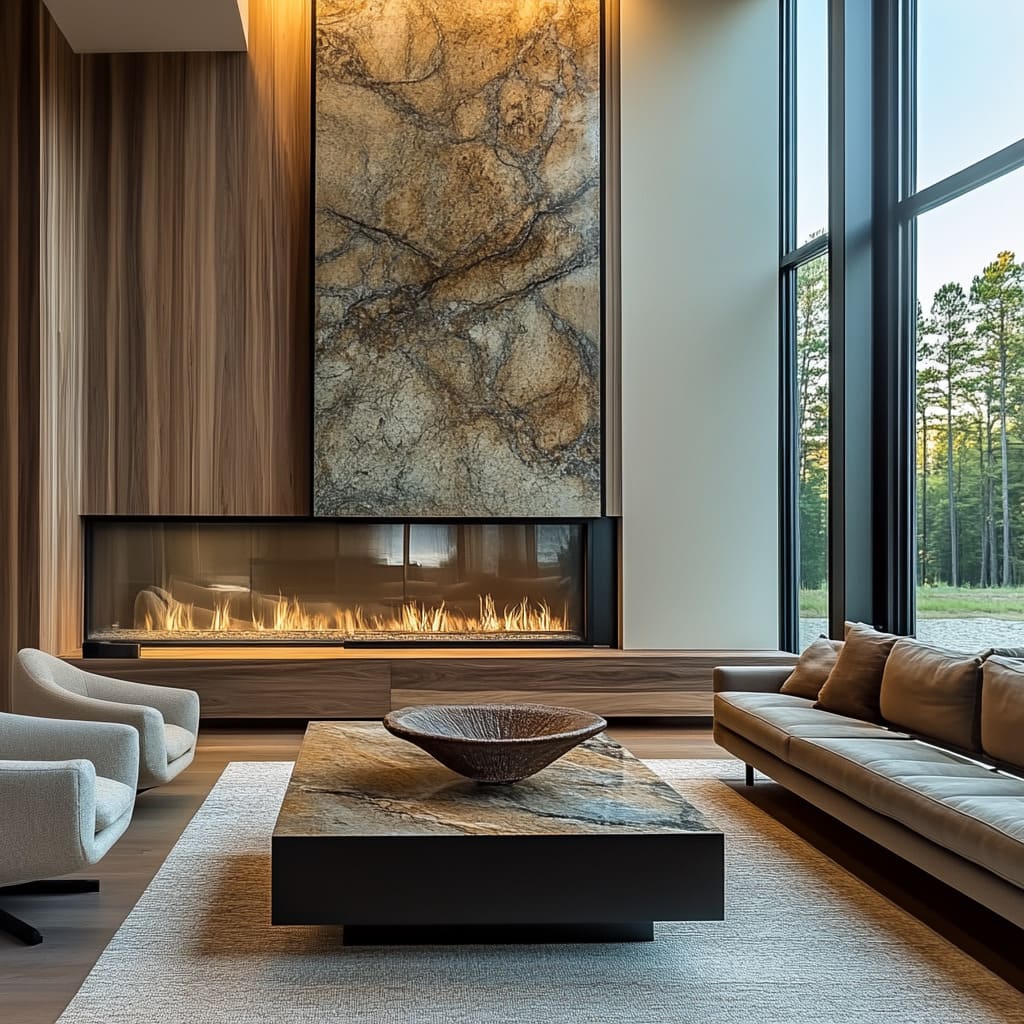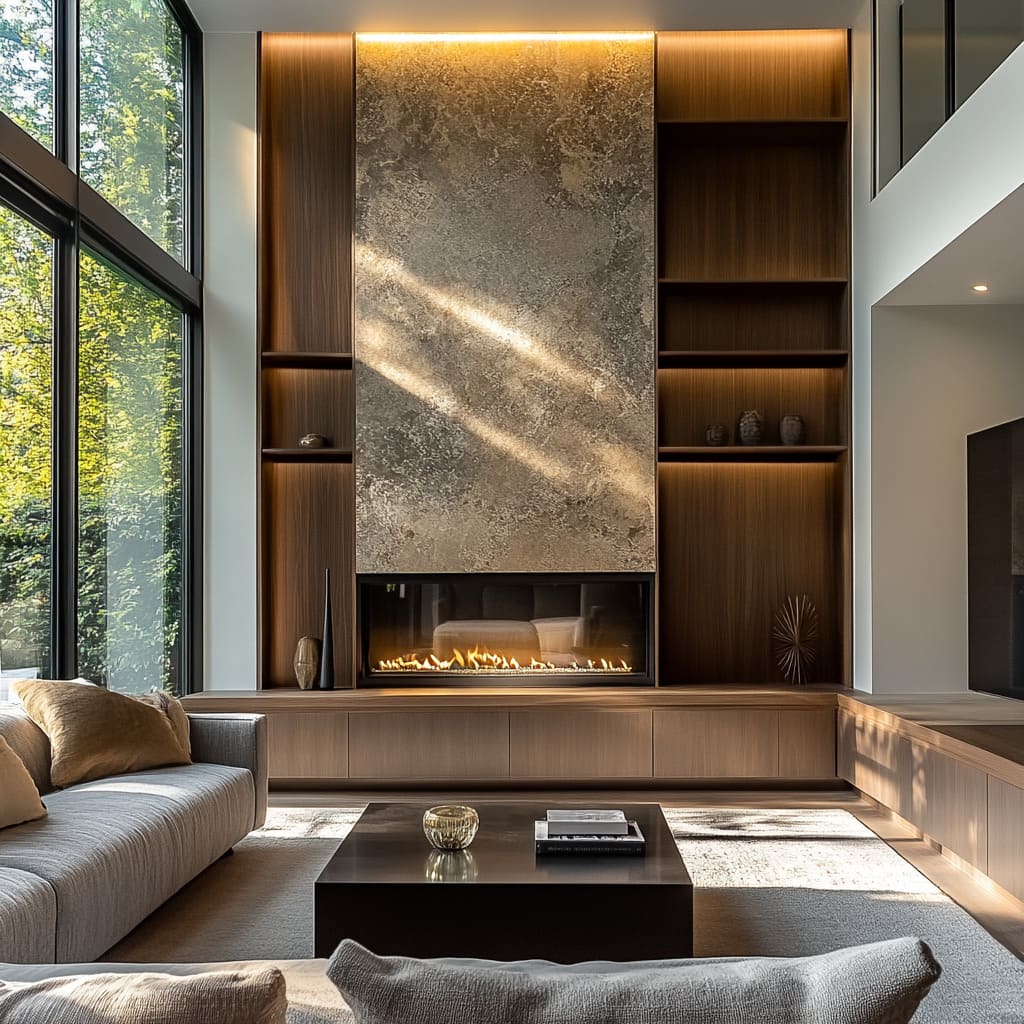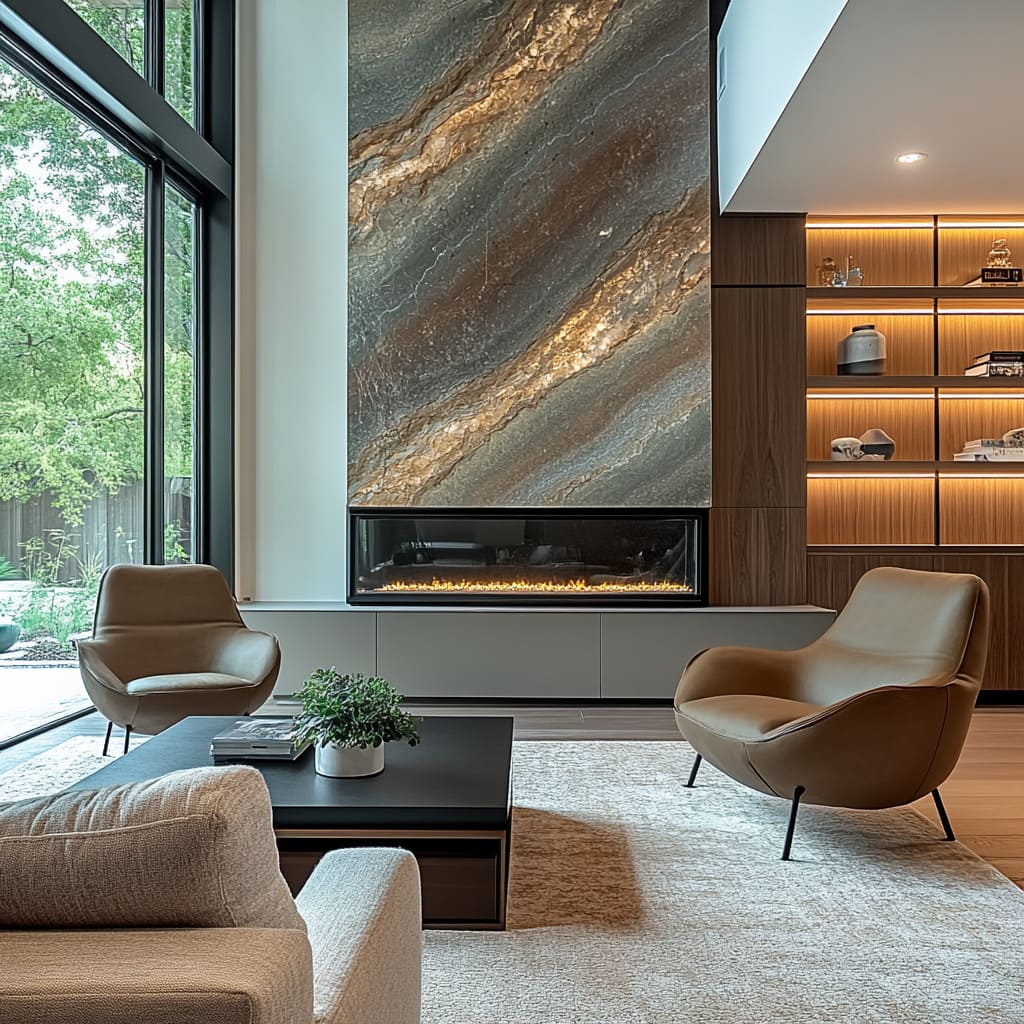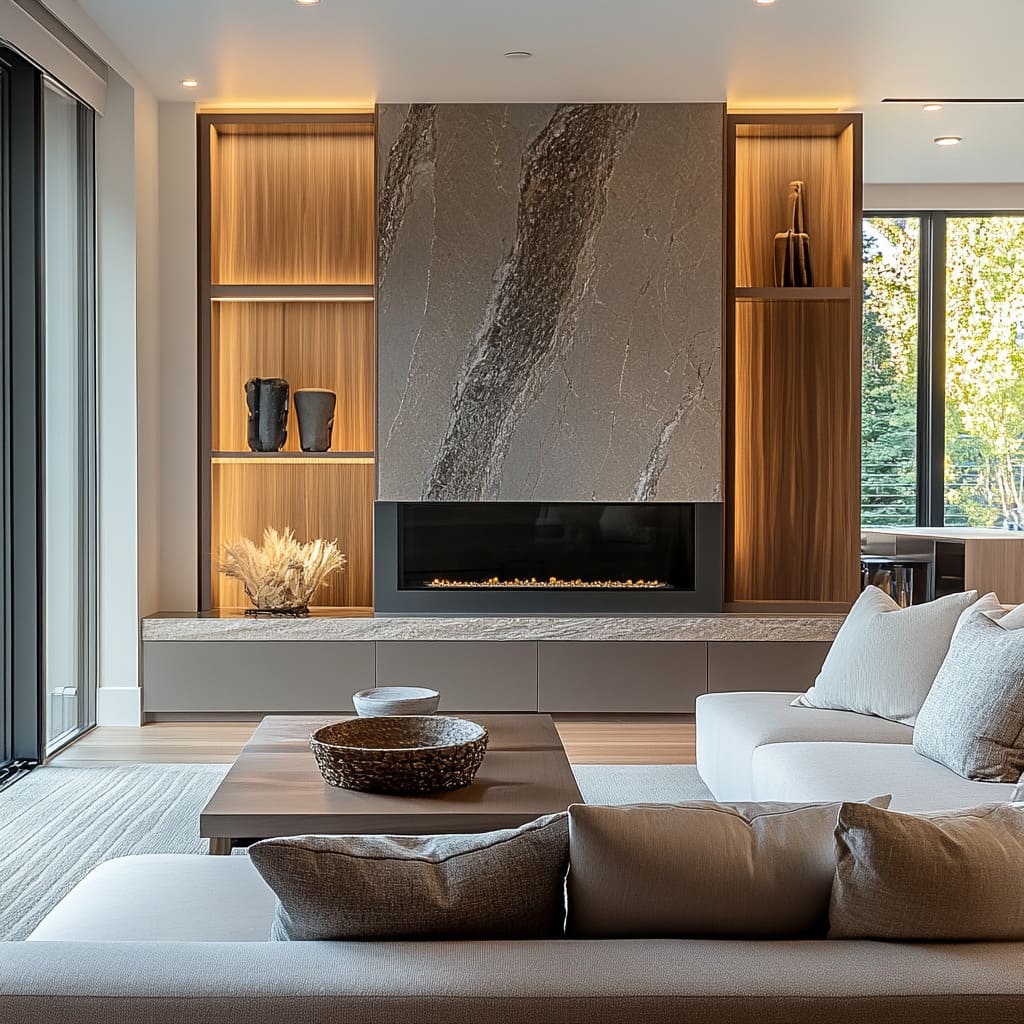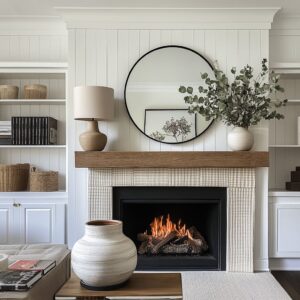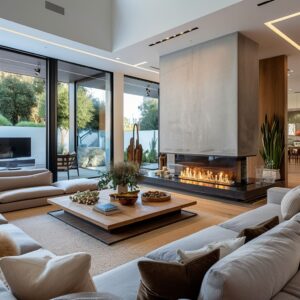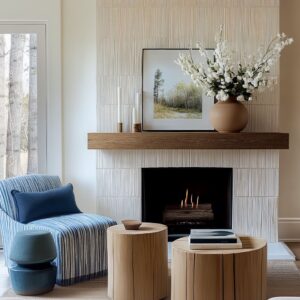Creating an eye-catching fireplace isn’t only about picking the right stone or choosing a sleek firebox—it’s about crafting a statement that draws the eye and shapes the atmosphere of a room. Designers use a combination of scale, lighting, and material contrasts to turn a fireplace into more than just a heat source.
From dramatic stone panels that feel like works of art to floating hearths that seem to defy gravity, every detail plays a role in making these fireplaces stand out.
This article takes a deep look at how modern fireplace ideas go beyond the basics. Instead of focusing on standard choices, it explores the finer details—how textures interact with light, how built-in shelving complements the structure, and how designers create balance between bold surfaces and soft surroundings.
By understanding these techniques, homeowners and designers alike can bring depth and personality into a space, turning a simple flame into the centerpiece of a room.
Balancing Large Slabs with Horizontal Lines
A contemporary fireplace isn’t just about a bold stone panel—it’s about how that panel interacts with the rest of the space. When designers use large slabs, especially those with striking veining, they often balance the vertical impact with strong horizontal lines.
This approach keeps the fireplace from feeling overwhelming while enhancing its role as a focal point.
A floating console, extended hearth, or built-in cabinetry running across the width of the wall adds stability, ensuring the eye moves smoothly across the design. Instead of towering over the space, the fireplace integrates seamlessly, creating a sense of proportion.
The contrast between tall and wide elements makes the room feel structured and intentional.
Another key technique is lowering the firebox itself. A high-set fireplace can feel distant, but when the flames sit closer to seating level, they naturally draw people in.
This subtle placement shift makes the fire feel inviting while keeping the grandeur of the stone slab intact. Whether in city lofts or open-concept homes, this balance is a signature feature of contemporary fireplace ideas, blending scale and warmth effortlessly.
Mixing Cool Stone with Warm Wood
Pairing stone with wood is one of the most effective ways to create a fireplace design that feels both refined and inviting. Stone, whether polished or textured, brings a sleek, sculptural quality, while wood softens the look with its natural warmth.
This balance keeps a fireplace from feeling too stark, ensuring it blends seamlessly into the living space.
The contrast between these materials isn’t just about appearance—it also affects the overall feel of the room. Stone carries a naturally cool tone, while wood introduces warmth, making the space feel more grounded.
The key is selecting wood tones that highlight subtle colors within the stone. Whether it’s deep walnut that echoes dark veining in marble or lighter oak that complements limestone, the right pairing makes the materials feel intentional rather than disconnected.
This mix is often seen in modern fireplace wall ideas, where designers use wood paneling to frame stone slabs or extend cabinetry to create a fluid connection. The combination allows for a structured yet relaxed look, keeping the fireplace as a strong focal point without making it feel overpowering.
Creating a Floating or Weightless Illusion
A fireplace that appears to hover adds a level of sophistication that instantly sets a space apart. Whether it’s a floating bench, an extended hearth with hidden supports, or shelving that seems to defy gravity, this technique gives the entire structure a sleek, effortless look.
The effect is often achieved by recessing support elements or using under-cabinet lighting to create soft shadows, making the fireplace feel lighter and more integrated into the room.
The absence of bulky legs or visible braces allows the focus to remain on the materials. Whether the design features a seamless stone slab or warm wood paneling, keeping the structure visually clean highlights the textures and finishes.
This approach is particularly popular in modern fireplace designs, where simplicity and precision define the aesthetic.
Subtle lighting plays a key role in enhancing the floating illusion. A soft glow beneath a stone ledge or along the underside of a console not only adds depth but also makes the fireplace feel more dynamic.
This technique works exceptionally well in open-plan living areas, ensuring the fireplace remains a striking centerpiece without feeling heavy or overpowering.
Intentional Furniture Placement and Proportions
A fireplace might be the visual anchor of a room, but the way furniture is arranged around it determines how inviting the space feels. Thoughtful placement ensures that the warmth—both physical and aesthetic—extends into the seating area, making the fireplace a true focal point rather than just a decorative feature.
The key is positioning chairs and sofas to create a natural flow toward the fire while maintaining balance with the rest of the room. Instead of a rigid, symmetrical setup, designers often angle lounge chairs slightly, allowing for an unobstructed view of both the flames and any striking stonework.
Sectionals or sofas typically face the fireplace head-on, sometimes with a coffee table or plush ottoman in between to reinforce a sense of gathering.
Spacing also plays a role in how the fireplace interacts with the room. A well-placed area rug can define the seating zone without overwhelming it, while a low-profile table ensures the fire remains visible without obstruction.
In open layouts, a curved or L-shaped sofa subtly guides movement through the space, making the seating arrangement feel connected rather than separate from the fireplace wall.
By adjusting proportions and keeping sightlines open, designers create a setting that feels both structured and comfortable—ensuring the fireplace isn’t just admired from afar, but truly enjoyed.
Adding Organic Touches to Offset Hard Surfaces
A modern fireplace can be a striking architectural feature, but without softer elements, it risks feeling too rigid or cold. This is where organic textures come in, adding warmth and balance to the design.
Whether it’s a vase filled with dried pampas grass, a sculptural branch placed on the hearth, or a potted plant nearby, these natural details break up the dominance of stone, metal, and glass, making the space feel more inviting.
Layering organic elements is one of the easiest ways to bring contrast to a fireplace setting. A well-placed ceramic vase with an earthy finish can soften the crisp lines of marble or slate, while a woven basket filled with firewood introduces texture without overpowering the space.
Even a subtle touch—like a trailing green plant on a built-in shelf—can shift the entire mood of the room.
This approach is often seen in modern fireplace decor ideas, where the goal is to create a balance between sleek surfaces and natural materials. Designers carefully select these elements to complement the room rather than clutter it.
The key is restraint—just a few organic accents can transform the fireplace into a focal point that feels both refined and welcoming.
Visual Continuity Between Firebox and Surrounding Materials
A fireplace should feel like an organic part of the space rather than a separate insert placed into a wall. One of the most effective ways to achieve this seamless look is by extending the firebox’s visual presence into the surrounding materials.
Dark firebox interiors blend effortlessly with matte black cabinetry, recessed panels, or shadowy stone, allowing the flames to stand out without any distractions.
This technique is especially useful in modern fireplace TV wall designs, where the goal is to create a unified, clutter-free aesthetic. By matching the firebox to the adjacent surfaces, designers ensure the structure feels cohesive rather than segmented.
The television, often mounted above or nearby, benefits from this same approach—its black screen merges with the surrounding paneling when turned off, preventing it from dominating the space.
Framing the flame with darker tones enhances the effect even further. When the surrounding elements recede, the flickering fire becomes the main visual feature, creating a striking contrast that draws the eye.
Whether set against charcoal stone, deep wood, or blackened steel, this method transforms a standard fireplace into an understated yet powerful design element.
Integrating the Fireplace with Media
A fireplace and a television often compete for attention in a living room, but when designed thoughtfully, they can work together without either one feeling out of place. The key is in the details—using recessed spaces, dark frames, and strategic placement to create a seamless transition between the two.
Instead of the TV sticking out as a separate element, designers ensure it blends into the surrounding materials, maintaining a clean and polished look.
One of the most effective techniques is setting the firebox and TV within a unified structure. When the screen is off, a dark recess or matte black paneling allows it to fade into the background, preventing it from overpowering the warmth of the fire.
Built-in cabinetry or shelving around the fireplace can also help balance the composition, offering a space for decorative elements that soften the contrast between technology and natural materials.
Hiding cables is another crucial step in keeping the design uncluttered. Whether the TV is mounted flush against stone, wood, or a custom-built media wall, concealed wiring ensures that nothing distracts from the overall aesthetic.
This approach works especially well in open-concept spaces where both the fireplace and television need to feel like part of the room’s natural flow.
By integrating these elements carefully, the fireplace remains a strong visual anchor, while the media screen enhances functionality without disrupting the design. The result is a setup that allows for both relaxation and entertainment, without sacrificing style.
Quiet Geometric Repetition
Some of the most visually pleasing fireplaces rely on repetition without making it obvious. Grid-like panels, aligned shelving, and cabinetry that mirrors the proportions of the firebox all create a rhythm within the design.
While these elements might not grab attention immediately, they provide a structured, balanced look that feels intentional.
This technique works particularly well in contemporary fireplace designs, where clean lines and subtle details define the space. By repeating rectangular shapes, whether through paneling, shelving, or hidden storage, designers establish a sense of order that makes the entire composition feel cohesive.
The firebox itself becomes a natural part of the arrangement rather than a separate element, blending seamlessly into the overall structure.
Even small details, like the spacing of tiles or the placement of recessed lighting, contribute to this effect. The result is a space that feels effortless, where every element supports the next.
Whether the goal is to create a bold architectural statement or a calm, structured backdrop, this approach ensures the fireplace remains visually grounded while still making an impact.
Conclusion
A modern fireplace is much more than a functional heat source—it’s a carefully curated design element that shapes the entire atmosphere of a space. Every detail, from the materials used to the way light interacts with different surfaces, plays a role in making it stand out.
Whether it’s a floating console that adds balance, subtle lighting that highlights textures, or a well-placed decorative piece that softens the composition, each component is intentionally chosen to enhance the overall effect.
The most striking fireplace designs don’t just sit within a room—they define it. Thoughtful combinations of stone and wood, strategic furniture placement, and seamless integration with built-in elements all contribute to a cohesive look that feels natural and inviting.
Paying attention to these finer details—like the way a firebox blends into its surroundings or how geometric patterns bring quiet structure—can turn an ordinary fireplace into an unforgettable statement piece.
By layering textures, playing with proportions, and using light to create depth, designers craft fireplaces that feel effortless yet impactful. Whether in a sleek city loft or a cozy home with natural wood tones, the right approach ensures the fireplace remains the heart of the space—both visually and functionally.
